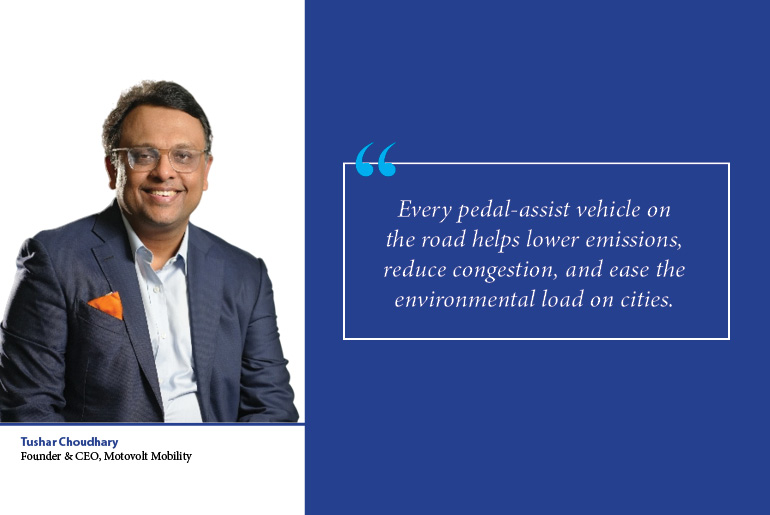India’s urban mobility landscape is undergoing a transformation. As per a report, nearly 70% of all motorised trips in Indian cities are under 8 km, and yet a significant number of these are still made using fuel-powered two-wheelers, contributing to congestion, emissions, and rising personal expenses. Growing cities are leading to an increase in traffic, environmental concerns, and other challenges. This also means that commuters are increasingly seeking cost-effective, efficient, and everyday travel transport options.
This is where a new category of electric vehicles is emerging: pedal-assist electric vehicles (pedelecs). For these riders, pedal-assist electric vehicles offer a practical alternative, bridging the functional gap between bicycles and scooters. In cities and towns where distances are short and traffic is dense, pedelecs provide a compelling answer. They combine manual pedalling with electric assistance, giving users the freedom to ride actively or switch to power support when needed. Their flexibility makes them convenient for daily commutes, first- and last-mile connectivity, and short trips.
Meeting real mobility needs
Pedal-assist vehicles are designed for the journeys that make up most of our daily lives: short trips to work, quick errands, and neighbourhood visits. As per data, over 60% of daily urban commutes in India fall under the 5–10 km range. A conventional scooter would be excessive in this regard, and a traditional bicycle can pose challenges with regard to the terrain.
This is where pedal-assist EVs enable the riders to pedal when they want to, use electric assistance as required, and switch between the two options as well. It helps in making mobility more flexible and accessible, without the associated constraints.
Affordability and convenience built in
One of the strongest reasons for the growing interest in pedal-assist vehicles is their affordability compared to conventional scooters, motorcycles, or app-based mobility services. The initial investment is lower than that of many scooters. Running costs are minimal, with no dependence on fuel and very low charging expenses. Regular maintenance is straightforward and costs are predictable, making ownership easy for a wide range of users.
For example, a delivery agent who switched from a second-hand petrol scooter to a pedal-assist EV. His monthly expenses on fuel and repairs dropped by over 70%, and he now covers short-range deliveries without worrying about rising fuel costs or vehicle upkeep. Battery prices have steadily declined in recent years, making quality electric mobility even more accessible. For urban and semi-urban commuters, this means they can opt for modern, efficient mobility without stretching their budgets.
Supporting an active lifestyle
Pedal-assist EVs naturally encourage healthier commuting habits. Riders can stay physically active on days when they choose to pedal more and lean on electric assistance when needed. Unlike scooters, which fully automate the ride, pedal-assist vehicles provide an active mobility option without setting high barriers for fitness or endurance. This lifestyle-friendly mobility solution supports both movement and convenience, adapting to the rider’s needs rather than the other way around.
Contributing to greener cities
Every pedal-assist vehicle on the road helps lower emissions, reduce congestion, and ease the environmental load on cities. With governments offering increasing support for sustainable transport and last-mile connectivity solutions, the potential for pedal-assist vehicles to play a bigger role in urban planning is significant.
For instance, the Electric Vehicle Policy introduced by the Delhi government has included subsidies for electric cycles used for commercial purposes. This shows the state’s intent to support cleaner, micro-mobility solutions. Another case in point is the integrated cycling tracks and last-mile mobility hubs in Bengaluru.
These efforts are also aligned with the United Nations SDGs, particularly Goal 11 — ‘Sustainable Cities and Communities,’ which promotes inclusive, safe, and environmentally friendly urban mobility.
As Indian cities expand and climate action becomes more urgent, vehicles like pedelecs are critical to creating transport ecosystems that are both equitable and ecologically responsible.
In conclusion
The future of mobility is adaptive, inclusive, and sustainable and pedal-assist electric vehicles are already emerging as a practical, affordable, and sustainable alternative. They are a cultural shift, away from heavy, fuel-dependent vehicles to agile, human-powered commuting solutions that are in sync with modern urban realities. As adoption grows, so does the opportunity to build cities and communities that move better and live better.


1 Comment
Hi there, I enjoy reading through yur post.
I like to write a little comment to support you.
Stop by my web site; dropshipping guide